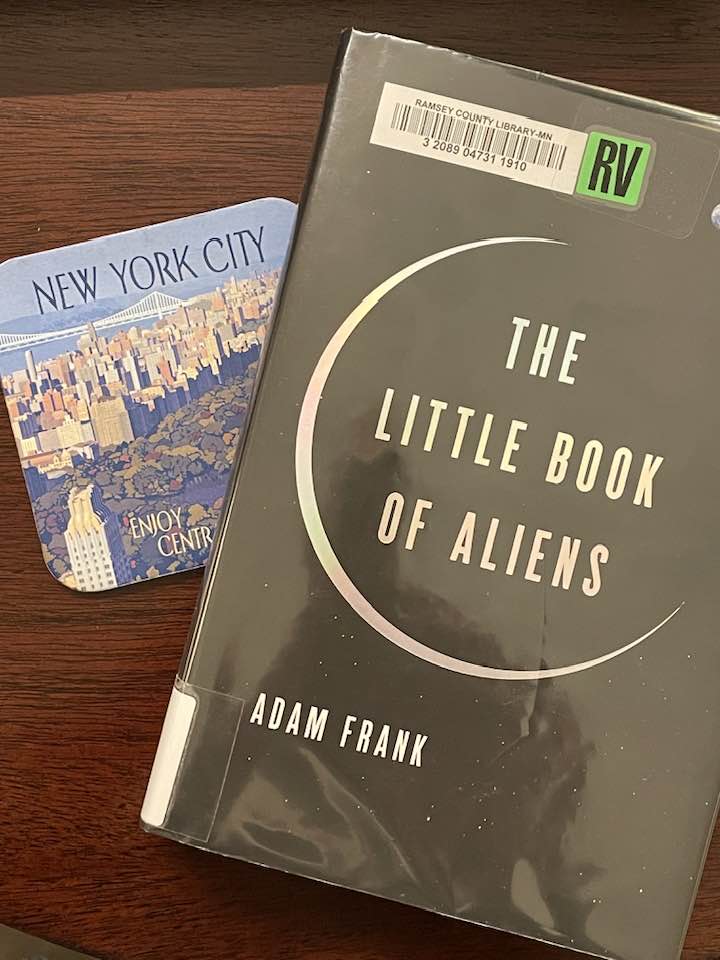MARCH 2, 2025 – Today I struggled to maintain good cheer, even a sense of humor, in the reverberatory wake of Friday’s devastating scene in the Oval Office. At regular intervals I received messages today from European friends/relatives expressing a combination of fear, anger, and dismay over our country’s open lurch into Putin’s clutches. To distract myself, I turned to our latest book club assignment, The Little Book of Aliens by Adam Frank, a professor of physics and astronomy at the University of Rochester. It was the right decision. Within a page I was deep into outer space.
For the better part of an hour, I was engrossed in the Drake equation and biosignatures, atmospheric characterization, and technospheres of exoplanets. The Drake equation, named after Frank Drake, an American astrophysicist and SETI (search for extraterrestrial intelligence) who developed it, is a formula for estimating the probability of intelligent communicative life elsewhere in the Milky Way.
This expedition of the mind transported me light years away from all the news and analyses of the bust-up of American democracy as it was configured up to January 20 of this year. While the light of our local sun lit up one page after another, I was having a blast on my far flung travels. I’d just finished a mind-blowing chapter about the three “snowball” phases that earth has survived—the longest one being around 500 million years, during which our entire globe was encased in snow and ice. Now my brain was flying across the Milky Way, a distance of 105,700 light years, if you can imagine that—which I cannot, and we’re talking about a single galaxy of an estimated 100 billion to 2 trillion galaxies in the observable universe.
To be honest, it felt good to be light years from Washington, D.C. and Moscow. But just then I heard the chant “Bring them home NOW!” coming from the park across the street from my sister and brother-in-law’s New York apartment. “It’s the weekly protesters,” said my sister. “Now, there’s persistence. They’re not about to let people forget the hostages,” she said sympathetically. Nor should we forget them in the daily havoc created by Caesar Trump and the ongoing chainsaw operations of King Midas. Trump and Musk! Just the thought of these destroyers and the confounding support they continue to enjoy from . . . adversaries of democracy . . . threatened to drag me back into a funk over humanity’s dysfunctionality.
Swooping back down to earth to save the day, however, was the brilliant (and very “down to earth”) Professor Adam Frank. After a detailed explanation of the science behind atmospheric characterization, the process of analyzing the composition of an exoplanet’s atmosphere as the exoplanet transits its star, Frank summarizes the mind-blowing achievement: “Sitting here on Earth, an astronomer can figure out exactly what’s in a planet’s atmosphere even if that planet is tens, hundreds, or thousands of light-years away.”
He then offers a positive take on our benighted species:
Thanks to this radical new method, we can see exactly what’s floating around in the atmospheres of planets that may never, ever be visited by a human. It is totally insane and amazing that we homo sapiens, basically just a bunch of hairless monkeys, have figured out how to probe distant alien atmospheres. If nothing else, this achievement should make you a little bit proud of us as a species in spite of all the other horrible stuff we do. (The Little Book of Aliens, p. 131)
Professor Frank’s observation cheered me up—until I realized that the achievement he describes, along with most of the other research covered in The Little Book of Aliens was funded with government grants. But I recovered quickly: Americans aren’t the only homo sapiens occupying the planet. If America is no longer a world leader, surely our former European allies will strive to fill the vacuum we’ve created—before the Chinese do.
Subscribe to this blog and receive notifications of new posts by email.
© 2025 by Eric Nilsson
